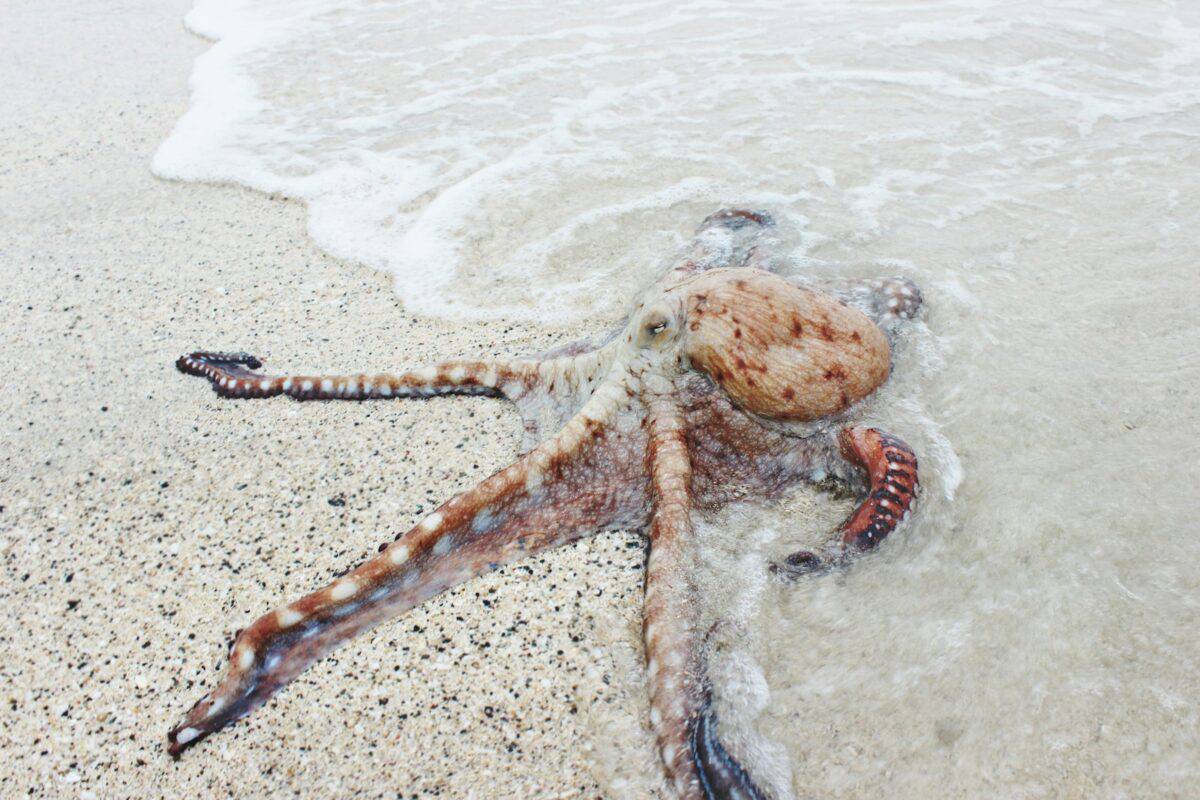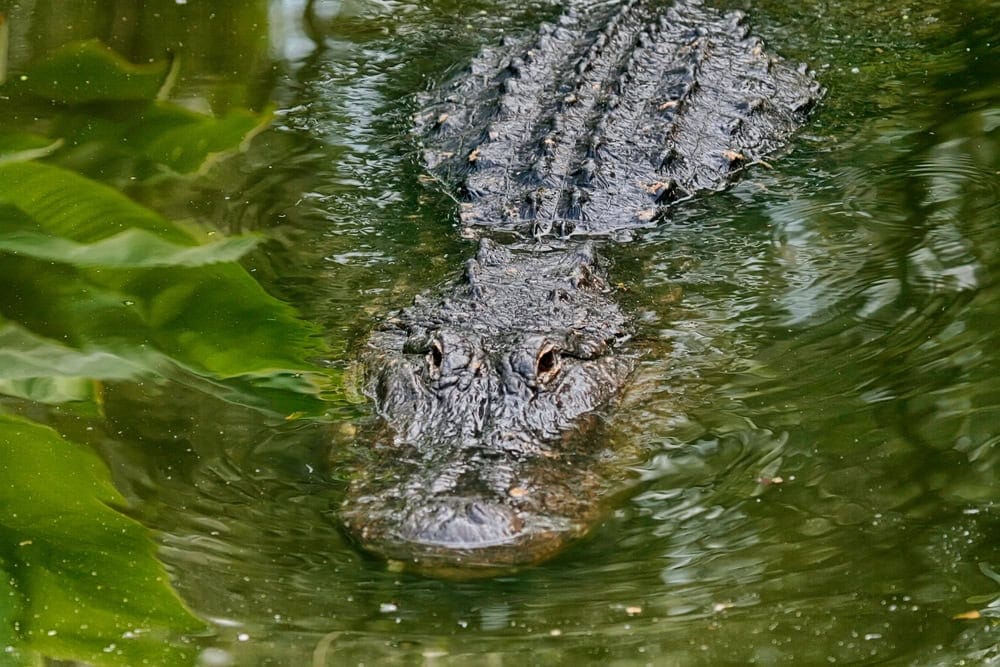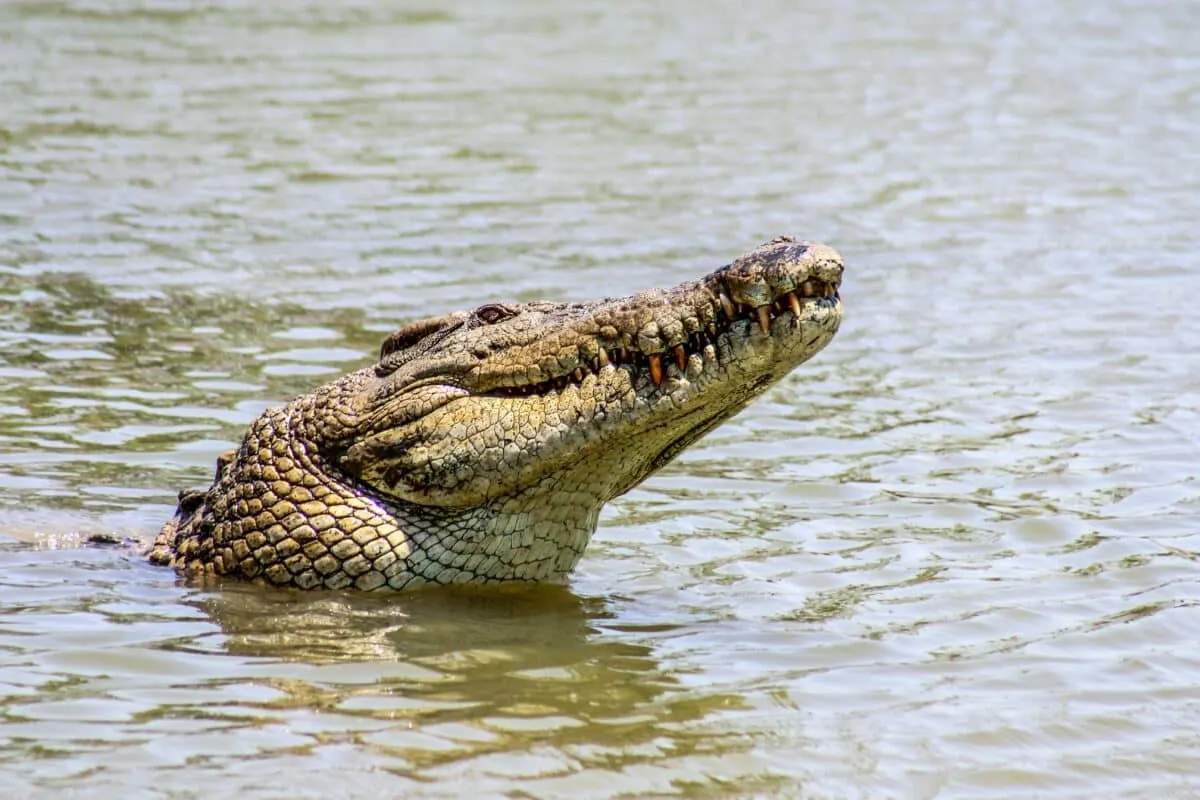Tool use was once considered the exclusive domain of humans, but research has revealed that many animal species employ tools in sophisticated ways—particularly for hunting. From crafting spears to using bait, these remarkable creatures demonstrate problem-solving abilities and intelligence that challenges our understanding of animal cognition. The following thirteen animals have developed ingenious methods of using objects in their environment to capture prey, showing that tool use is far more widespread in the animal kingdom than previously believed. Each species has evolved unique approaches to tool utilization that enhance their hunting success, demonstrating that this advanced cognitive capability has emerged independently multiple times throughout evolutionary history.
13. Chimpanzees Nature’s Spear Hunters

Chimpanzees are perhaps the most accomplished non-human tool users in the animal kingdom. In the Fongoli savanna of Senegal, researchers have documented chimpanzees systematically crafting wooden spears for hunting. These intelligent primates carefully select branches, strip them of leaves and side stems, and sharpen one end using their teeth. They then use these handcrafted weapons to stab into tree hollows and crevices where bushbabies (small nocturnal primates) sleep during the day. This deliberate crafting of hunting tools demonstrates remarkable foresight and planning, as the chimps create the tools before arriving at hunting locations. Female chimps have been observed using this hunting technique more frequently than males, suggesting complex social dynamics around tool-based hunting in chimpanzee societies.
12. Octopuses The Ocean’s Clever Toolmakers

Octopuses, despite being invertebrates with a nervous system vastly different from mammals, display remarkable tool use while hunting. The veined octopus (Amphioctopus marginatus) has been observed collecting discarded coconut shells, cleaning them, and carrying them for future use as shelter—a clear example of planning ahead. More directly related to hunting, some octopus species use tools defensively to avoid becoming prey themselves. They stack rocks to block the entrances to their dens when resting, preventing predators from entering. When hunting, certain octopus species have been documented using objects as weapons, propelling rocks, shells, and even human debris at threatening fish and other animals. Their ability to manipulate objects with their flexible arms and problem-solve makes them uniquely equipped for tool use among invertebrates.
11. Crocodiles Stick-Baiting Predators

Crocodiles have displayed a surprising level of hunting intelligence through their use of sticks as bait. During bird nesting seasons, researchers have observed Nile crocodiles balancing sticks and branches on their snouts while partially submerged near the shoreline. Wading birds seeking nesting materials are attracted to these sticks, bringing them within striking distance of the powerful crocodile’s jaws. What makes this behavior particularly remarkable is that crocodiles deliberately place these sticks during specific seasons when birds are collecting nesting materials, suggesting an understanding of timing and bird behavior. Given that crocodilians have existed for over 200 million years, this sophisticated cognitive ability challenges assumptions about reptilian intelligence and demonstrates how evolutionary pressures can produce complex behaviors even in ancient lineages.
10. Sea Otters Marine Mammals with Stone Tools

Sea otters are famous for their stone tool use, which they employ with remarkable dexterity. These marine mammals use rocks as anvils to crack open hard-shelled prey like crabs, sea urchins, abalones, and mussels. An otter will dive to the ocean floor to collect a prey item, then resurface. It places a flat stone on its chest while floating on its back, then uses a second stone to repeatedly strike the shell until it breaks open. What’s particularly fascinating is that sea otters often have a favorite stone that they’ll keep for extended periods, storing it in a loose pouch of skin under their forelimbs when diving for prey. Studies have shown that this tool use is culturally transmitted, with young otters learning the technique by observing their mothers. This sophisticated behavior helps sea otters access nutritious food sources that would otherwise be inaccessible, allowing them to thrive in their ecological niche.
9. Archerfish Precision Water Shooters

Archerfish have evolved one of the most unusual hunting tools in the animal kingdom—their ability to shoot down prey with precisely aimed jets of water. These fish, native to brackish waters of Southeast Asia and Australia, feed primarily on insects that perch on vegetation above the water. To capture these otherwise inaccessible meals, archerfish have developed specialized mouth structures that allow them to expel a powerful stream of water at speeds up to 6 meters per second. The fish compensate for light refraction at the water-air interface, effectively solving a complex physics problem to accurately hit targets up to 3 meters away. Young archerfish aren’t born with this ability but must learn it through practice and observation, suggesting cognitive complexity beyond innate behavior. While their water jets aren’t external objects in the traditional sense of tool use, biologists consider this manipulation of water as a sophisticated natural tool that demonstrates the fish’s remarkable adaptive capabilities.
8. Bottlenose Dolphins Sponge-Nosed Hunters

In Shark Bay, Western Australia, a remarkable cultural behavior has been documented among bottlenose dolphins. Certain dolphins, predominantly females, break marine sponges from the seafloor and wear them over their rostrum (beak) while foraging on the seabed. This behavior, known as “sponging,” protects their sensitive snouts as they probe the rough sandy bottom for fish that hide beneath the surface. The sponge acts as a tool that allows these dolphins to access food resources that non-sponging dolphins cannot, creating a specialized ecological niche. Research has shown that this behavior is primarily passed from mother to daughter through social learning, creating a matrilineal cultural tradition that has persisted for generations. This represents one of the best-documented cases of tool use and cultural transmission in marine mammals and demonstrates the sophisticated cognitive abilities of dolphins to adapt and innovate hunting techniques.
7. Egyptian Vultures Egg-Smashing Specialists

Egyptian vultures display remarkable tool use in their specialized feeding strategy for accessing ostrich eggs, which are protected by shells too thick for the birds to break with their beaks alone. These vultures deliberately select stones of appropriate size and weight, then use precise throwing motions to strike the eggs repeatedly until the shell cracks. What makes this behavior particularly impressive is that it appears to be innate rather than learned, with even hand-raised vultures that have never observed the behavior demonstrating the stone-throwing technique when first presented with eggs. Some populations of Egyptian vultures have adapted this behavior to modern contexts, using human-made objects or dropping eggs onto rocks when stones aren’t available. This specialized tool use has allowed Egyptian vultures to access a nutritious food source that most other scavengers cannot, giving them a significant advantage in their harsh desert environments.
6. Gorillas Using Natural Tools as Measuring Sticks

While less renowned for tool use than their chimpanzee cousins, gorillas employ tools in more subtle yet sophisticated ways when foraging. Mountain gorillas have been observed using sticks to test water depth before crossing streams—a form of tool use that helps them determine safe passage. In captivity, gorillas have shown even more advanced tool capabilities, using branches to retrieve food placed outside their enclosures and stacking boxes to reach elevated items. Western lowland gorillas have been documented using branches as walking sticks for support when traversing marshy terrain and as poles for balance when reaching for aquatic plants in swampy areas. Though gorillas may not craft weapons for active hunting like chimpanzees, their thoughtful use of environmental objects demonstrates problem-solving skills and situational awareness that helps them safely navigate their environment while foraging for food.
5. New Caledonian Crows Avian Tool Crafters

New Caledonian crows are among the most sophisticated avian tool users, crafting and using tools with a complexity once thought exclusive to primates. These remarkable birds fashion hooks from twigs and serrated cutting tools from the leaves of pandanus plants, which they use to extract insect larvae from deadwood and crevices. What makes their tool use extraordinary is the level of standardization and improvement in their designs—they create tools of consistent shapes optimized for specific hunting tasks and modify them if they prove ineffective. Young crows learn these skills through observation and practice, with tool designs varying between different populations, suggesting the existence of distinct crow “cultures.” Laboratory studies have shown these crows can solve multi-step problems requiring insight and planning, such as using a short stick to retrieve a longer stick that can then reach food. This cognitive flexibility and tool sophistication is particularly remarkable in a brain that weighs just a few grams.
4. Bonobos Versatile Hunting Tool Users

Bonobos, the close relatives of chimpanzees, demonstrate diverse tool use in hunting contexts, though they are generally less predatory than their chimpanzee cousins. In the wild, bonobos have been observed using sticks to dig for earthworms and probe tree holes for honey. They also use leafy branches to swat at and capture flying insects, demonstrating tool use specifically for prey acquisition. What makes bonobo tool use particularly interesting to researchers is that these apes appear more willing to share both tools and the food obtained with them than chimpanzees, reflecting their more cooperative social structure. In captivity, bonobos have shown remarkable aptitude for creating and using tools, including cracking nuts with hammers and using sticks as levers—capabilities they likely possess but use less frequently in the wild due to abundant food sources in their native habitats. This suggests that tool use in bonobos may be more a matter of necessity and opportunity than cognitive limitation.
3. Elephants Tool-Wielding Giants

Elephants, with their combination of dexterous trunks and advanced cognition, are accomplished tool users in both wild and captive settings. While elephants are herbivores and don’t use tools directly for hunting prey, they employ tools extensively in their foraging, which involves “hunting” for plant foods. Wild elephants have been documented breaking branches specifically to use as fly swatters, digging sticks, and back scratchers. They fashion branches into tools of appropriate length and shape for specific tasks, demonstrating intentional modification. In Thailand, researchers have observed elephants modifying branches to create tools precisely suited for breaking electric fences—removing all side branches and leaves except for a Y-shaped hook at the end. Asian elephants have demonstrated understanding of cause-and-effect by stepping on one end of a stick to make the other end rise where food is balanced, showing insight into physical relationships. Their tool use demonstrates remarkable problem-solving abilities and adaptation to environmental challenges in their search for food.
2. Ants Collective Tool Users

Several ant species demonstrate collective tool use in hunting and food acquisition, challenging our understanding of insect cognition. Among the most remarkable are the Aphaenogaster ants, commonly known as funnel ants, which use small objects like leaves, soil particles, and sand grains to transport liquid food. When encountering liquid food sources that they cannot carry directly, these ants drop small solid materials into the liquid, which absorb it, and then carry these soaked tools back to their nests. In laboratory settings, they selectively choose the most absorbent materials available, showing evaluation of tool properties. Another impressive example comes from army ants, which construct “living bridges” with their bodies to cross gaps and create shortcuts to prey. Some ant species even use tools defensively, with certain Dorylus driver ants depositing debris at nest entrances that potential intruders disturb, alerting the colony to threats. This collective tool use emerges from distributed cognition across the colony rather than individual intelligence, representing a fundamentally different evolutionary path to tool use than that seen in vertebrates.
1. Alligators and Herons An Unexpected Partnership

American alligators have been observed engaging in a fascinating behavior that borders on tool use, involving a mutually beneficial relationship with wading birds like herons. During nesting season, alligators will position small sticks and twigs on their heads while partially submerged near bird colonies. Nesting birds, attracted to these building materials, approach the seemingly harmless floating debris, only to be captured by the waiting alligator. What makes this behavior particularly notable is its seasonal timing and apparent intentionality—alligators specifically display this behavior during bird nesting seasons when the strategy would be most effective. Some researchers debate whether this constitutes true tool use or is better classified as baiting, but the deliberate manipulation of objects to attract prey meets many definitions of tool utilization. This hunting strategy demonstrates cognitive sophistication in reptiles that challenges traditional views of reptilian intelligence and suggests that the evolutionary benefits of tool use have led to its development across diverse animal lineages.
Conclusion: The Evolutionary Significance of Animal Tool Use

The widespread occurrence of tool use across such diverse animal groups demonstrates that this cognitive ability has evolved independently multiple times throughout evolutionary history. Far from being a uniquely human trait, tool use appears whenever the ecological pressures and physical capabilities of a species make it advantageous. The examples highlighted in this article challenge traditional hierarchical views of animal intelligence and suggest a more nuanced understanding of cognition across the animal kingdom. For many species, tool use represents a critical adaptation that allows access to otherwise unavailable food resources, creating ecological niches that would otherwise be inaccessible. Perhaps most significantly, the diversity of tool use in hunting contexts reveals that problem-solving and innovation are fundamental aspects of animal cognition that deserve greater recognition and study across biological disciplines.
- 13 Most Dangerous U.S. Wildlife - August 20, 2025
- Animals in Idaho - August 20, 2025
- 10 Mammals You Did not Know Could Swim - August 20, 2025

